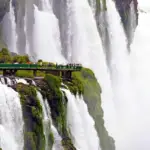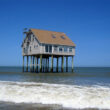Nestled deep in the heart of eastern Siberia, Russia, lies a small town that holds the chilling distinction of being the coldest inhabited place on Earth. This remote settlement, known as Oymyakon, has endured some of the most extreme temperatures ever recorded on the planet. In fact, Oymyakon’s frigid climate has earned it the title of the coldest inhabited place, surpassing even the extreme temperatures of Antarctica.
But how does a town like Oymyakon survive in such a harsh environment? In this article, we explore the history, unique features, and challenges of living in this icy frontier.

A Chilly Record: The Coldest Temperature Ever Recorded
Oymyakon is known for a truly bone-chilling record—a minimum temperature of -71.7°C (-96.1°F) was recorded there in February 1933. This staggering temperature is officially the lowest ever recorded in a human settlement, even colder than some areas of Antarctica. To put this into perspective, the average temperature in Oymyakon during winter months can dip to an icy -50°C, making it a place where extreme cold is a way of life.
The town’s extreme cold is a result of its geographic location in the Siberian Taiga, an expansive forest that stretches across eastern Russia. Oymyakon is situated within a valley that traps cold air, exacerbating the freezing temperatures, particularly in the long, dark winter months.
Meaning Behind the Name: Water That Doesn’t Freeze
The name Oymyakon comes from the local Yakut language and translates to “water that doesn’t freeze.” This refers to the nearby hot springs, which, despite the bone-chilling temperatures of the region, remain unfrozen throughout the year. These hot springs offer a contrast to the harsh surroundings, providing locals with a rare natural source of warmth in an otherwise frozen world.
The springs are not only a unique geographical feature but also an important resource for the people of Oymyakon. In a place where everything else seems to freeze, these warm waters are a critical part of daily life. Historically, the hot springs have served as a gathering place for the locals, offering a brief respite from the harsh cold.
Life in the Cold: A Population of 450
Oymyakon has a population of approximately 450 people, most of whom are ethnic Yakuts, an indigenous group native to the region. Despite the extreme cold, the residents of Oymyakon have learned to adapt and make their lives in one of the most inhospitable environments on Earth.
In winter, temperatures can plummet to -50°C, which means that houses and buildings must be specially designed to withstand the freezing cold. Residents rely on heating systems powered by wood or coal to keep their homes warm. Vehicles are equipped with special engines that can start at incredibly low temperatures, and even the tires of cars are adjusted to prevent them from freezing solid.
The townspeople’s resilience is impressive. People dress in layers of fur and wool to protect themselves from the elements, and the harsh environment has led to the development of a strong, community-focused culture. Despite the challenges, the people of Oymyakon continue to live and thrive in one of the most extreme climates on Earth.
Like Us on Facebook!
Challenges of Living in Oymyakon
Life in Oymyakon comes with a unique set of challenges, many of which are unimaginable to those living in more temperate climates.
Subscribe Us on YouTube!
1. Harsh Winters
The cold is perhaps the biggest hurdle for Oymyakon’s residents. Winter in the town lasts for nearly six months, with temperatures regularly dipping below -40°C. This prolonged cold can be tough to endure, especially when basic tasks like going outside, driving, or getting fresh food become increasingly difficult.
2. Limited Resources
The town has limited access to modern conveniences. Due to its remote location, Oymyakon has few amenities, and residents rely on nearby towns for many supplies. Fresh produce and perishable goods are scarce, especially during the winter months when transportation becomes more difficult.
3. Isolation
Oymyakon’s location in the wilderness means that it is cut off from the rest of the world for much of the year. During the winter, roads may become impassable, and communication with other areas can be limited. The isolation of Oymyakon is a defining feature of life there, making it even more of a challenge to maintain a modern lifestyle.
The Resilience of Oymyakon’s People
Despite the extreme cold and difficult conditions, the people of Oymyakon display remarkable resilience. The town’s population continues to maintain its traditional way of life, while also adapting to modern changes. In recent years, the region has seen some improvements in infrastructure, including better access to electricity and telecommunications.
The residents’ ability to survive in such a challenging environment speaks to the strength of the human spirit. In Oymyakon, survival is not just about enduring the cold; it’s about creating a way of life that harmonizes with the natural world, even in the most inhospitable of places.
Tourism and Oymyakon’s Global Fame
While Oymyakon remains a small, isolated town, it has attracted attention from around the world due to its extreme temperatures and unique lifestyle. Adventure seekers, scientists, and curious travelers make their way to Oymyakon each year to experience its freezing climate firsthand.
In recent years, the town has become somewhat of a tourist destination, with people visiting to witness its coldest days and to learn about the lives of those who call this place home. The townspeople, however, remain cautious about the influx of outsiders. Their way of life is intensely private, and while they welcome visitors, they are also keenly aware of the challenges that come with being part of such a remote and harsh environment.
Conclusion
Oymyakon is more than just the coldest inhabited place on Earth—it’s a symbol of human resilience and adaptability. Despite temperatures that would deter most people, the inhabitants of Oymyakon continue to live and thrive in one of the harshest climates imaginable. The town’s unique name, “water that doesn’t freeze,” offers a glimpse into the balance between extreme cold and the rare sources of warmth in this unforgiving environment.
Living in Oymyakon requires a special kind of strength, one that involves not only surviving but finding ways to make life in the world’s coldest place possible. The town may be small, but it is a testament to the remarkable endurance of the human spirit in the face of nature’s most extreme conditions.



















